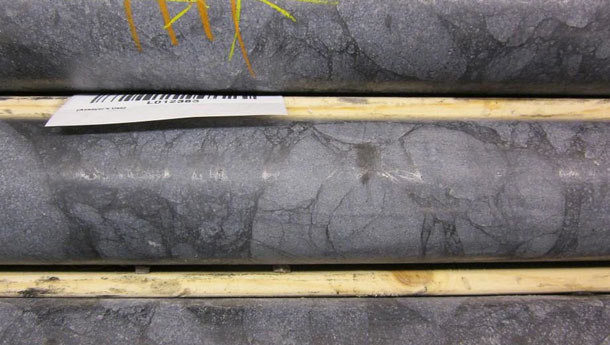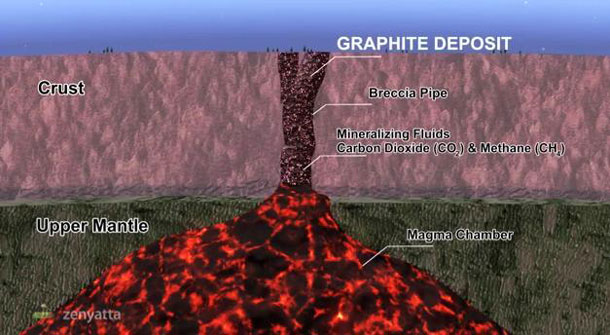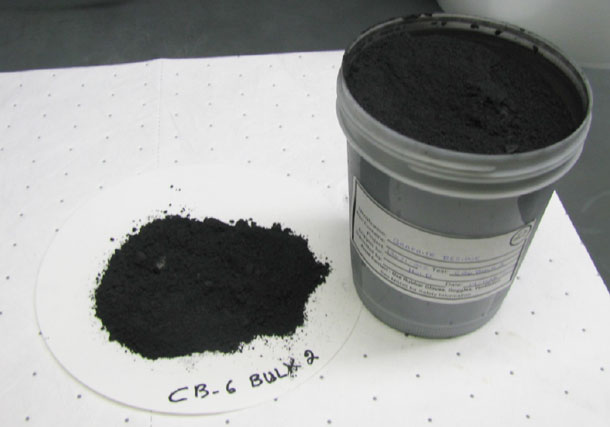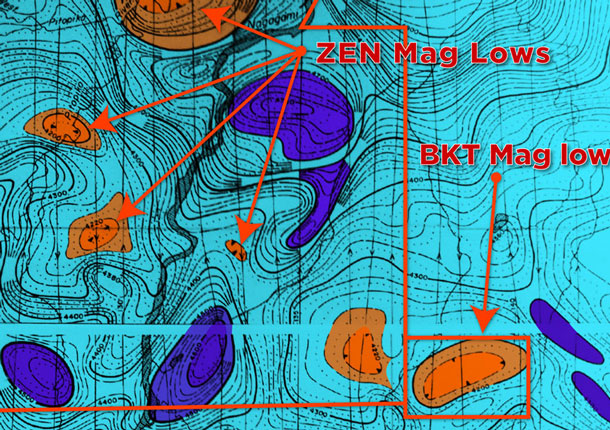
Zenyatta Ventures Updates Albany Project Testing Results
THUNDER BAY – BUSINESS – Zenyatta Ventures Ltd. (“Zenyatta” or “Company”) (TSX VENTURE:ZEN) (OTCQX:ZENYF) are updating the pilot plant & metallurgical testing at SGS Canada Inc. (‘SGS’) facility in Lakefield, Ontario. The flotation pilot plant results, while confirming earlier bench-scale testing, produced a concentrate that has been upgraded at laboratory scale to a high purity and highly crystalline graphite product using a caustic bake based process.
Highlights:
— Glow Discharge Mass Spectrometry (‘GDMS’) results show less than 0.05%
elemental impurities (or greater than 99.95% purity of highly
crystalline graphitic carbon (“Cg”));
— No deleterious elemental concerns and verifying good crystal structure
(hexagonal with real density of 2.25 g/cc);
— Produced samples of high purity graphite material for market evaluation
& testing by more than 20 end users.
Additional test work is underway to produce a higher grade flotation concentrate feed to further optimize the purification process and provide extra high purity material for testing by interested parties. This optimization work will provide additional information for the flow sheet and the preliminary economic assessment (PEA) which is to be completed in the 4th quarter.
Bharat Chahar, VP Market Development of Zenyatta stated “The recent work has produced high purity graphite material which has been sent to various potential customers for testing and evaluation and will be sent to others in the coming days. Test work completed to date has confirmed the Zenyatta graphite to have a very good crystal structure (hexagonal) with a very desirable real density of 2.25 g/cc. We have no elemental purity concerns, including sulphur (67 ppm), boron (0.12 ppm) and equivalent boron content (‘EBC’) of 0.919 ppm. The sulphur and boron are very low with EBC measuring well below the recommended maximum of 5ppm for nuclear applications. The Company will continue to produce a high purity graphite product (for various applications) with strict specifications based on dialogue with interested end users under a signed confidentiality agreement.”
Peter Wood, VP Exploration of Zenyatta stated, “The pilot plant has proven to be very useful in the early evaluation and troubleshooting for the flow sheet design. The test-work will continue and provide the necessary engineering data for energy requirements, water treatment, reagent consumption and equipment sizing. We expect to develop a distinctive process for this unique graphite deposit.”
Environmental Advantage – Zenyatta
The world trend is to develop products for technological applications that need extraordinary performance using ultra-high purity graphite powder at an affordable cost. High purity and highly crystalline graphite material is gaining prominence in the clean-tech sector at a time when Zenyatta discovered an extremely rare (hydrothermal) graphite deposit. The Albany deposit can be upgraded with very good crystallinity without the use of aggressive acids and high temperature thermal treatment therefore having an environmental advantage over other types of upgraded high purity graphite material. Large multi-national corporations need to protect their image (public profile) in this environmentally conscious age. They are positioned as environmentally responsible companies and must remain so in this extremely competitive world. If raw materials, like high purity graphite, are sourced from environmentally damaging processes or jurisdictions, it could seriously harm the company brand.
Aubrey Eveleigh, President and CEO of Zenyatta stated, “Generally speaking, corporations interested in Zenyatta’s graphite product are looking for large tonnage (long-life), high quality ‘raw material’ resources capable of producing a superior and consistent high purity product. They also have a strong interest in an environmentally sound and cost-effective process in a politically stable jurisdiction.”
Zenyatta continues to develop the unique Albany Graphite Deposit in Ontario, Canada. The Company’s highly crystalline graphite deposit is situated 30 km north of the Trans-Canada Highway, power line and natural gas pipeline near the communities of Constance Lake First Nation and Hearst. A rail line is located 70 km away with an all-weather road approximately 10 km from the graphite deposit.
RPA Inc. estimates showed Indicated Mineral Resources to date totaling 25.1 million tonnes at an average grade of 3.89% graphitic carbon (“Cg”), containing 977,000 tonnes of Cg. In addition, Inferred Mineral Resources delineated to date are estimated to total 20.1 million tonnes at an average grade of 2.20% Cg, containing 441,000 tonnes of Cg. The upcoming PEA technical data will include among other items: open pit mining methods, metallurgy and processing, infrastructure, environment, manpower requirements, marketing and price assumptions, capital and operating costs, life of mine plan and execution plan.
The outlook for the global graphite market is very promising with demand growing rapidly from new applications. Graphite is now considered one of the more strategic elements by many leading industrial nations, particularly for its growing importance in high technology manufacturing and in the emerging “green” industries such as electric vehicle components. The application for graphitic material is constantly evolving due to its unique chemical, electrical and thermal properties. It maintains its stability and strength under temperatures in excess of 3,000 degrees C and is very resistant to chemical corrosion. It is also one of the lightest of all reinforcing elements and has high natural lubricating abilities. Some of these key physical and chemical properties make it critical to modern industry.
GDMS is a technique for the direct determination of trace elements in a variety of materials. GDMS enables the elemental analysis of solid samples by sputtering in a low-pressure DC argon discharge. The sputtered atoms are ionized in this plasma and extracted into the mass spectrometer for separation and detection. Three (3) separate samples were analyzed and the average value is reported. The calculated graphitic carbon (‘Cg’) purity is by difference of wt % from total elemental impurities. Where GDMS reported an element concentration as below the detection limit, the detection limit concentration value was used in the calculation of total impurity content. All GDMS analyses were performed by Evans Analytical Group in Liverpool, New York. Equivalent boron content (‘EBC’), expressed as parts per million (ppm) was calculated according to ASTM C1233-09 (Standard Practice for Determining Equivalent Boron Contents of Nuclear Materials). The metallurgical test work is being performed under the supervision of Alex Mezei, M.Sc., P.Eng., Director, Engineering Technical Services at SGS Lakefield and Peter Wood, P.Eng., P.Geo., VP Exploration of Zenyatta. Peter Wood and Alex Mezei are the Qualified Person’s under National Instrument 43-101 who supervised the preparation of the scientific and technical information that forms the basis for the disclosure contained in this news release.












